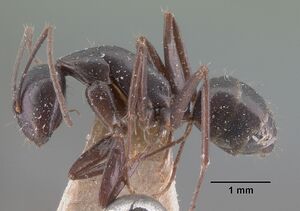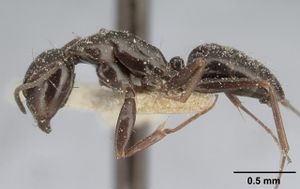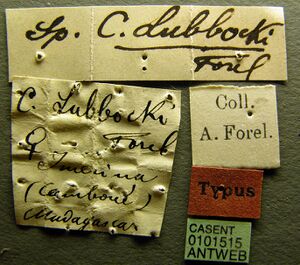Camponotus lubbocki
| Camponotus lubbocki | |
|---|---|

| |
| Scientific classification | |
| Kingdom: | Animalia |
| Phylum: | Arthropoda |
| Class: | Insecta |
| Order: | Hymenoptera |
| Family: | Formicidae |
| Subfamily: | Formicinae |
| Tribe: | Camponotini |
| Genus: | Camponotus |
| Subgenus: | Myrmosaga |
| Species: | C. lubbocki |
| Binomial name | |
| Camponotus lubbocki Forel, 1886 | |
| Synonyms | |
| |
Camponotus lubbocki commonly occurs in montane shrubland and montane rainforests in the northeast, central, and southern high plateau of Madagascar. The species is rarely known from rainforests and the transitional forest between spiny and dry forests. Across this mountainous region, the species nests mostly in the ground, in root mats in the ground, and under moss on the ground, but occasionally nests in rotten logs and under stones. (Rakotonirina & Fisher, 2018)
Identification
In full-face view, lateral margin of head anterior to eye level diverging posteriorly; anterior clypeal margin truncate; no white spot on dorsum of second and third abdominal tergites; body color black; antennal scape without erect hairs, propodeal dorsum slightly concave. (Rakotonirina & Fisher, 2022)
Camponotus lubbocki might be confused with Camponotus liandia but the latter has a broadly convex anteromedian margin of the clypeus. It looks similar to Camponotus immaculatus and Camponotus kelimaso because they too lack white spots on the second and third abdominal segments, but in C. immaculatus the propodeal dorsum is transversely concave and in C. kelimaso the eyes are small and the posterior cephalic margin is approximately straight.
Forel (1912) originally placed C. lubbocki under the subgenus Myrmosaga, which was later synonymized by Emery (1925) under Mayria (see also Rakotonirina and Fisher 2018). Whereas this species was recently redescribed under Mayria, it is morphologically similar to those within Myrmosaga because of its broadly projected rectangular clypeus that is medially carinate, and a more or less anteroposteriorly flattened petiolar node. The subgenus Mayria is characterized by the clypeus that has no median carina, but with a rounded anterior margin, and a nodiform petiole. Therefore, C. lubbocki was moved back to the subgenus Myrmosaga by Rakotonirina & Fisher (2022).
Keys including this Species
- Key to Malagasy Camponotus Mayria
- Key to minor workers of the Malagasy Camponotus, subgenus Myrmosaga
Distribution
Latitudinal Distribution Pattern
Latitudinal Range: -12.616667° to -24.24067°.
| North Temperate |
North Subtropical |
Tropical | South Subtropical |
South Temperate |
- Source: AntMaps
Distribution based on Regional Taxon Lists
Malagasy Region: Madagascar (type locality).
Distribution based on AntMaps
Distribution based on AntWeb specimens
Check data from AntWeb
Countries Occupied
| Number of countries occupied by this species based on AntWiki Regional Taxon Lists. In general, fewer countries occupied indicates a narrower range, while more countries indicates a more widespread species. |

|
Estimated Abundance
| Relative abundance based on number of AntMaps records per species (this species within the purple bar). Fewer records (to the left) indicates a less abundant/encountered species while more records (to the right) indicates more abundant/encountered species. |

|
Biology
Castes
Worker
Images from AntWeb
   
| |
| Paralectotype of Camponotus lubbocki rectus. Worker (major/soldier). Specimen code casent0101106. Photographer April Nobile, uploaded by California Academy of Sciences. | Owned by NHMB, Basel, Switzerland. |
   
| |
| Worker. Specimen code casent0101437. Photographer April Nobile, uploaded by California Academy of Sciences. | Owned by MNHN, Paris, France. |
   
| |
| Worker. Specimen code casent0101438. Photographer April Nobile, uploaded by California Academy of Sciences. | Owned by MNHN, Paris, France. |
   
| |
| Lectotype of Camponotus lubbocki rectus. Worker. Specimen code casent0101512. Photographer April Nobile, uploaded by California Academy of Sciences. | Owned by MHNG, Geneva, Switzerland. |
   
| |
| Paralectotype of Camponotus lubbocki rectus. Worker (major/soldier). Specimen code casent0101514. Photographer April Nobile, uploaded by California Academy of Sciences. | Owned by MHNG, Geneva, Switzerland. |
   
| |
| Paralectotype of Camponotus lubbocki. Worker. Specimen code casent0101516. Photographer Nick Olgeirson, uploaded by California Academy of Sciences. | Owned by MHNG, Geneva, Switzerland. |
   
| |
| Paralectotype of Camponotus lubbocki rectus. Worker. Specimen code casent0101105. Photographer April Nobile, uploaded by California Academy of Sciences. | Owned by NHMB, Basel, Switzerland. |
Queen
Images from AntWeb
   
| |
| Paralectotype of Camponotus lubbocki. Queen (alate/dealate). Specimen code casent0101515. Photographer April Nobile, uploaded by California Academy of Sciences. | Owned by MHNG, Geneva, Switzerland. |
Male
Images from AntWeb
     
| |
| Male (alate). Specimen code casent0172790. Photographer April Nobile, uploaded by California Academy of Sciences. | Owned by MCZ, Cambridge, MA, USA. |
Nomenclature
The following information is derived from Barry Bolton's Online Catalogue of the Ants of the World.
- lubbocki. Camponotus lubbocki Forel, 1886f: 186 (w.) MADAGASCAR.
- Forel, 1891b: 61 (q.); Forel, 1891b: 216 (s.).
- Combination in C. (Myrmosaga): Forel, 1912i: 92;
- combination in C. (Mayria): Emery, 1925b: 123.
- Status as species: Forel, 1891b: 60 (redescription), 216; Dalla Torre, 1893: 240; Emery, 1896d: 374 (in list); Forel, 1907g: 91; Wheeler, W.M. 1922a: 1046; Emery, 1925b: 123; Bolton, 1995b: 109; Rakotonirina & Fisher, 2018: 35 (redescription).
- Senior synonym of christoides Rakotonirina & Fisher, 2018: 35.
- Senior synonym of rectus Rakotonirina & Fisher, 2018: 35.
- christoides. Camponotus lubbocki r. christoides Forel, 1891b: 61 (w.) MADAGASCAR.
- Combination in C. (Mayria): Emery, 1925b: 123.
- Status as species: Dalla Torre, 1893: 224.
- Subspecies of lubbocki: Emery, in Dalla Torre, 1893: 240 (footnote); Emery, 1896d: 374 (in list); Wheeler, W.M. 1922a: 1046; Emery, 1925b: 123; Bolton, 1995b: 92.
- Junior synonym of lubbocki: Rakotonirina & Fisher, 2018: 35.
- rectus. Camponotus lubbocki var. rectus Forel, 1891b: 217 (w.) MADAGASCAR.
- Combination in C. (Mayria): Emery, 1925b: 123.
- Subspecies of lubbocki: Dalla Torre, 1893: 240; Emery, 1896d: 374 (in list); Wheeler, W.M. 1922a: 1046; Emery, 1925b: 123; Bolton, 1995b: 120.
- Junior synonym of lubbocki: Rakotonirina & Fisher, 2018: 35.
Unless otherwise noted the text for the remainder of this section is reported from the publication that includes the original description.
Description
Worker
Rakotonirina and Fisher (2018) - Minor. In full-face view, head elongate and rectangular, posterolateral margin rounding to the roughly straight posterior margin. Clypeus with broadly rounded anterior margin and remarkable anterolateral angles; median carina visible and fully developed. Eyes not breaking lateral outlines of head, their posterior margins located far behind the midlength of the head (PoOc/CL: 0.27±0.01; 0.25–0.30). Mandible triangular, apical margin with six sharp teeth. Antennal scape long, its basal half nearly reaching posterior cephalic border. In lateral view, pronotum and anterior portion of mesonotum noticeably convex; posterior portion of mesonotum and propodeal dorsum straight; junction of propodeal dorsum and declivity surface broadly angulate; propodeal dorsum roughly three times longer than height of declivity; propodeal spiracle slit-like. Petiolar node higher than long and tapering dorsally.
Sparse, erect hairs, shorter than height of propodeal declivity and abundant, long pubescence present on dorsum of head, mesosoma, petiole and gaster; body color entirely reddish-black to black.
Major. With characteristics of minor worker, except for the following characters: enlarged head, with slight medial excision on posterior margin; medially concave anterior clypeal margin; apical third of antennal scape surpassing posterior cephalic margin; pronotum and mesonotum forming an even convexity and separated from propodeum by distinct metanotum.
Type Material
- Camponotus lubbocki: Lectotype (designated by Rakotonirina & Fisher, 2018: 35.), minor worker, Imerina Antananarivo [Fianarantsoa, Amoron’I Mania, Ambositra, Fahizay, 1317 m], Madagascar, 20°30′00″S 47°20′00″E / 20.5°S 47.333332°E, Camboué, CASENT0101518, Musee d'Histoire Naturelle Genève.
- Camponotus lubbocki: Paralectotype (designated by Rakotonirina & Fisher, 2018: 35.), 1 major worker, 1 alate queen, Imerina Antananarivo [Fianarantsoa, Amoron’I Mania, Ambositra, Fahizay, 1317 m], Madagascar, 20°30′00″S 47°20′00″E / 20.5°S 47.333332°E, Camboué, CASENT0101516, CASENT0101515, Musee d'Histoire Naturelle Genève.
- Camponotus lubbocki christoides: Holotype, minor worker, Antsiranana Province, Lokobe, Madagascar, O’Swald; (not seen by Rakotonirina & Fisher, 2018).
- Camponotus lubbocki rectus: Lectotype (designated by Rakotonirina & Fisher, 2018: 35), minor worker, Süd Central Madagascar [Fianarantsoa Urban, Haute Matsiatra, 2eme Arrondissement, 1160 m], Madagascar, 21°26′00″S 47°05′00″E / 21.433332°S 47.083332°E, Hildebrandt, CASENT0101512, Musee d'Histoire Naturelle Genève.
- Camponotus lubbocki rectus: Paralectotype (designated by Rakotonirina & Fisher, 2018: 35), 1 worker, Süd Central Madagascar [Fianarantsoa Urban, Haute Matsiatra, 2eme Arrondissement, 1160 m], Madagascar, 21°26′00″S 47°05′00″E / 21.433332°S 47.083332°E, Hildebrandt, CASENT0101514, Musee d'Histoire Naturelle Genève.
- Camponotus lubbocki rectus: Paralectotype (designated by Rakotonirina & Fisher, 2018: 35), 2 minor worker, Forêt d’Andrangoloaka [Mantasoa, Manjakandriana, 1409 m], Madagascar, 19°02′00″S 47°55′00″E / 19.033333°S 47.916668°E, Sikora, CASENT0101105, CASENT0101106, Naturhistorisches Museum, Basel.
References
- Emery, C. 1925d. Hymenoptera. Fam. Formicidae. Subfam. Formicinae. Genera Insectorum 183: 1-302 (page 123, Combination in C. (Mayria))
- Forel, A. 1886h. Études myrmécologiques en 1886. Ann. Soc. Entomol. Belg. 30: 131-215 (page 186, worker described)
- Forel, A. 1891c. Les Formicides. [part]. In: Grandidier, A. Histoire physique, naturelle, et politique de Madagascar. Volume XX. Histoire naturelle des Hyménoptères. Deuxième partie (28e fascicule). Paris: Hachette et Cie, v + 237 pp. (page 216, soldier described)
- Forel, A. 1891c. Les Formicides. [part]. In: Grandidier, A. Histoire physique, naturelle, et politique de Madagascar. Volume XX. Histoire naturelle des Hyménoptères. Deuxième partie (28e fascicule). Paris: Hachette et Cie, v + 237 pp. (page 60, queen described)
- Forel, A. 1912j. Formicides néotropiques. Part VI. 5me sous-famille Camponotinae Forel. Mém. Soc. Entomol. Belg. 20: 59-92 (page 92, Combination in C. (Myrmosaga))
- Rakotonirina, J.C., Fisher, B.L. 2018. Taxonomic revision of the Malagasy Camponotus subgenus Mayria (Hymenoptera, Formicidae) using qualitative and quantitative morphology. Zootaxa 4438: 1–58 (DOI 10.11646/zootaxa.4438.1.1).
- Rakotonirina, J.C., Fisher, B.L. 2022. Revision of the Malagasy Camponotus subgenus Myrmosaga (Hymenoptera, Formicidae) using qualitative and quantitative morphology. ZooKeys 1098: 1–180 (doi:10.3897/zookeys.1098.73223).
- Rasoamanana, N., Fisher, B.L. 2022. A taxonomic revision of the Malagasy endemic subgenus Mayria of the genus Camponotus (Hymenoptera, Formicidae) based on qualitative morphology and quantitative morphometric analyses. ZooKeys 1081: 137–231 (doi:10.3897/zookeys.1081.71872).
- Wheeler, W. M. 1922k. Ants of the American Museum Congo expedition. A contribution to the myrmecology of Africa. IX. A synonymic list of the ants of the Malagasy region. Bull. Am. Mus. Nat. Hist. 4 45: 1005-1055 (see also)
References based on Global Ant Biodiversity Informatics
- Emery C. 1886. Saggio di un catalogo sistematico dei generi Camponotus, Polyrhachis e affini. Memorie della Reale Accademia delle Scienze dell'Istituto di Bologna 5: 363-382
- Fisher B. L. 1997. Biogeography and ecology of the ant fauna of Madagascar (Hymenoptera: Formicidae). Journal of Natural History 31: 269-302.
- Fisher B. L. 2003. Formicidae, ants. Pp. 811-819 in: Goodman, S. M.; Benstead, J. P. (eds.) 2003. The natural history of Madagascar. Chicago: University of Chicago Press, xxi + 1709 pp.
- Forel A. 1886. Études myrmécologiques en 1886.. Annales de la Société Entomologique de Belgique. 30: 131-215.
- Forel A. 1907. Ameisen von Madagaskar, den Comoren und Ostafrika. Wissenschaftliche Ergebnisse. Reise in Ostafrika 2: 75-92.
- Rakotonirina J. C., and B. L. Fisher. 2018. Taxonomic revision of the Malagasy Camponotus subgenus Mayria Hymenoptera, Formicidae) using qualitative and quantitative morphology. Zootaxa 4438: 1-58.
- Wheeler W. M. 1922. Ants of the American Museum Congo expedition. A contribution to the myrmecology of Africa. IX. A synonymic list of the ants of the Malagasy region. Bulletin of the American Museum of Natural History 45: 1005-1055

